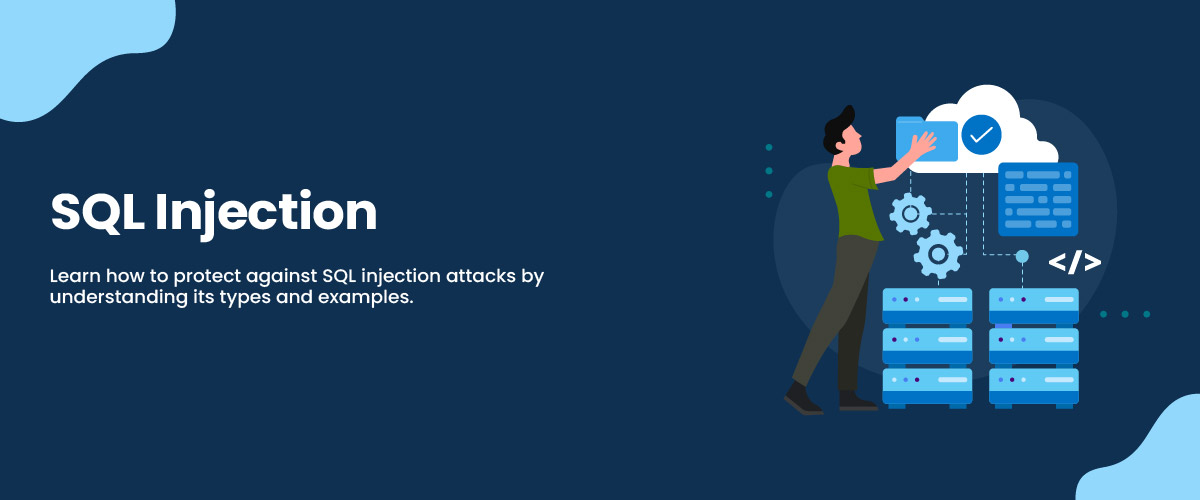What is SQL Injection Attack in Cyber Security?
Did you know that the first SQL injection attack was discovered 20 years ago? Despite its long tenure, these attacks make up two-thirds of website attacks even today. SQL injections or SQLi are the most common and dangerous vulnerabilities that online hackers exploit.
In this type of attack, a SQL query is “injected” into the program through the client’s input data. In this article, you will learn in-depth about SQL injections and how they can access data that can completely destroy your database by using malicious SQL codes.
SQL injection attack is a type of cyber security attack in which an attacker inserts malicious code into a SQL query, taking advantage of a vulnerability in the software running on the target system to obtain access or steal sensitive data.
What is a SQL Injection Attack?
A SQL injection attack is a kind of cyber security attack in which an attacker inserts malicious code into a SQL query, taking advantage of a flaw in the software running on the target system to obtain access or steal sensitive data. Attackers can use SQL injections to bypass authentication and gain control over vulnerable web applications that use client-supplied data without proper validation before passing it on. They can use SQL injection to alter the database by adding, changing, or removing records.
Types of SQLi Attacks
The following are SQL injection types that attackers can use to access a website’s database without authorization.
- Classic SQL Injection Method: This happens when an attacker corrupts the website by embedding malicious code. It sends an altered message to the database using the usual communication channel and uses information learned from the response to gain insights about the structure or contents of the database.
- Blind or Inference SQL Injection Method: This method is frequently used when classic attack methods do not work. It is more tricky to detect as the website doesn’t respond with an error message, making it challenging to spot the issue. With this technique, attackers can steal data from the website’s database, including usernames and passwords.
- Error-based SQL Injection Method: The attackers use this method to extract data from the database by using the website’s error messages. For example, the attacker may run a query that results in an error and reveals details about the database schema or the names of the tables.
- Union-Based SQL Injection Method: This type of attack involves the use of injecting a SQL query that combines the results of multiple SELECT statements to fetch data from multiple tables as a single result set. The attacker can extract data using this technique from several database tables.
- Time-Based SQL Injection Method: In this type of attack, no data is transferred between the attacker and the database. The attacker won’t be able to get results as easily as in an in-band injection attack. The attacker injects a query that causes a delay in the server’s response time. This method can help the attacker determine if the website is vulnerable to SQL injection and can also be used to extract information from the database.
How does SQLi Work?
SQL injection works by exploiting security loopholes in a website’s code that allow an attacker to execute malicious SQL statements into the website’s input fields. SQL injection in DBMS is a type of cyber security attack that exploits a flaw in the software running on the target system to obtain access to the data.
SQL injection attacks are a major security risk when building web applications. This happens when malicious user input is allowed to be used as part of a SQL statement, which accesses information from the backend databases. Attackers can inject various control characters and command keywords (e.g., single quotes (‘), double quotes (“), equals (=), comments (- -)) that change the structure of the query being made by the application against its database server, allowing them to modify or gain access to data elements stored there.
Malicious code for this attack usually originates from untrusted sources or even within system databases if not properly secured. Therefore, it is essential to ensure that your website’s code is robust enough to withstand SQL injection in DBMS attacks.
SQL Injection Demo
Do you know how easy it is for hackers to steal sensitive information from your website? Take a look at this SQL injection demo.
Using SQL Injection to Authenticate as an Administrator
This example displays how a hacker can use SQL injection to breach a program’s authentication and gain administrator rights.
In this situation, the user enters their username and password into variables called “user” and “pass.” These values get combined with a SQL statement by way of concatenation:
sql = "SELECT id FROM users WHERE username='" + user + "' AND password='" + pass + "'";The issue here is that it leaves room for manipulation as attackers are capable of replacing the “pass” variable with one such string like “password’ OR 5=5”.
This results in forming the following query when executed on databases including MySQL, PostgreSQL & Oracle,
SELECT id FROM users WHERE username='user' AND password='pass' OR 5=5'.This is because every outcome rendered from this clause will be true, regardless of what credentials were provided initially. It means that any individual who sets up this query gains access by bypassing the authentification requirement. Consequently, they will be able to acquire admin privileges.


How is a SQL Injection Used?
It’s important to note that a SQL injection attack is unethical. The following information is being provided strictly for educational reasons. To execute a SQL injection attack, an attacker typically follows these few key steps:
- Identify a Vulnerable Website: To employ SQL injection attacks, a website must be vulnerable. The attacker will search for websites with security holes that SQL injection attacks can exploit. Websites with poor coding techniques, such as ones that do not adequately validate user input, frequently have these vulnerabilities.
- Identify Injection Points: Once a vulnerable website has been located, the attacker will seek input fields where they may insert malicious SQL queries, such as login forms or search fields.
- Craft Malicious SQL Statements: In this step, the attacker can introduce SQL statements that take advantage of the website’s weaknesses, such as adding a “union select” statement to a search bar input to extract information from the website’s database.
- Execute the Attack: The attacker will input the malicious SQL statement into the vulnerable input field and execute the attack. If successful, the attacker will gain unauthorized access to the website’s database.
- Extract Data: Once inside the database, the attacker can extract sensitive data, such as usernames and passwords, financial information, or other private information.
Also, read about Advantages of cyber security
How to prevent a SQL Injection Attack?
To prevent SQL injection attacks in the context of cyber security, website developers must ensure that their code is secure, properly inspected, sanitized, and that input fields are parameterized. To protect against SQL injection vulnerabilities, it is recommended to implement the following security measures.
- Ensure staff involved in building web applications are informed of possible security risks associated with SQL injections.
- Do not rely on user input; all inputs must be treated cautiously when developing a SQL query or using certain data structures.
- Double-check for authentication and implement whitelists instead of blacklists to ensure quality control over incoming data flows.
- Use up-to-date development tools with built-in security protection methods rather than trying to self-build protective frameworks.
- Use existing security measures such as parameterized queries or stored procedures instead of creating a custom solution.
- Utilize scan applications regularly.
- Additionally, users should exercise caution when providing personal information on websites and avoid using the same password on several websites.
SQL Injection Payloads
The following are the SQL injection payloads.
- Generic SQL Injection Payloads: These kinds of strings are commonly used and created to exploit weaknesses in SQL database systems. For example, an attacker injects a query that activates a SQL syntax error allowing the attacker to gain more insights into the database schema and exploit it further.
- Generic Error-Based Payloads: These payloads rely on the presence of generated SQL errors, which provide useful information about the underlying database’s structure. For instance, an attacker can learn more about the database structure and potentially improve their ability to exploit it by inserting a query that results in a SQL syntax error.
- Generic Time-Based SQL Injection Payloads: These payloads are made to exploit flaws that let attackers stall the execution of SQL statements. These are generic time-based SQL injection payloads. Attackers can make the database take longer to answer requests by injecting a delay statement like “sleep()” or “benchmark()”, which can reveal details about the database’s data and structure.
- Generic Union Select Payloads: These payloads take advantage of the SQL operator “UNION,” which enables attackers to combine the outcomes of various searches into a single result set. Attackers can get data from several tables at once by injecting a query that uses UNION SELECT.
- SQL Injection Auth Bypass Payloads: These payloads are intended to circumvent authentication processes by altering the SQL query used to verify user credentials. An attacker can defeat authentication. For instance, inserting a query that always returns “true” enables them to access a system without a working account and password.
If you want to learn more about SQL then an SQL course is a great way to expand your knowledge on this subject matter.
Conclusion
SQL injection attacks are the sneakiest hacker ploy in the book. It can access your system, take your data, and wreak havoc on your company with only a few keystrokes. Further, it can make sensitive information accessible to hackers. By putting input validation and security procedures in place, you may safeguard the database of your website. So, keep up with the latest security measures and shield your website against sneaky assaults.







